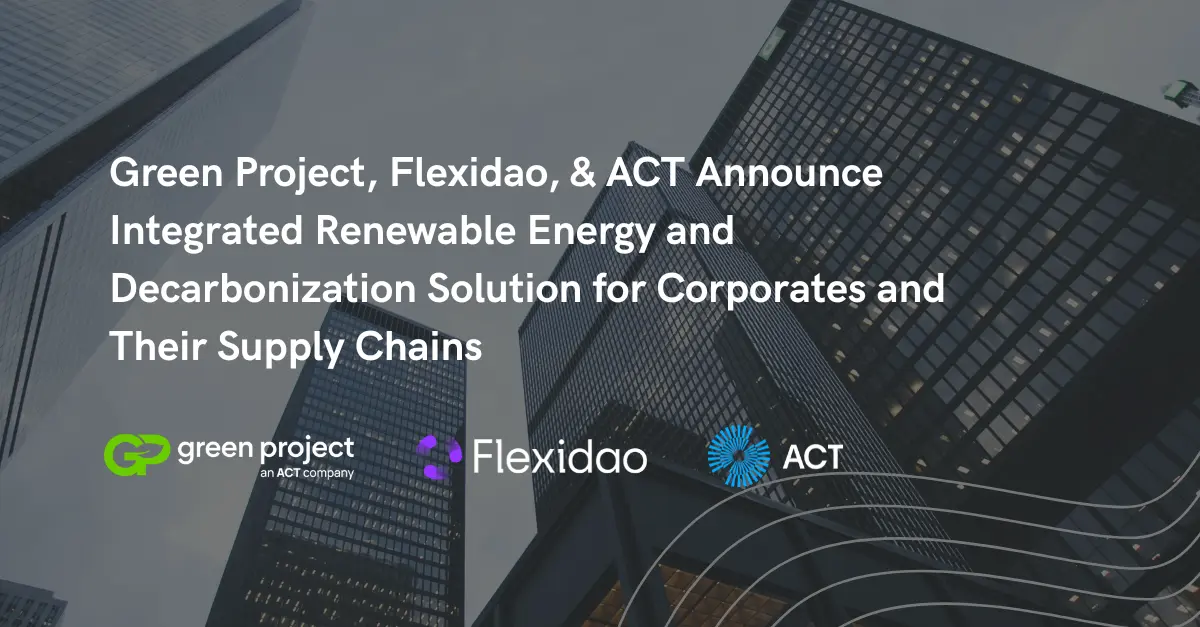How to Reduce the Cost of Corporate Energy and Sustainability Reporting
How to Reduce the Cost of Corporate Energy and Sustainability Reporting
Cut costs in energy and sustainability reporting with Flexidao. Simplify CDP and RE100 compliance with our energy data management solutions.
For most companies, the green transition has brought about cost-savings opportunities such as the ability to procure low-cost renewable power. However, it has also led to increased costs in the form of additional compliance and regulation, annual sustainability reporting, and new staffing requirements.
One of the major challenges faced by corporations when reporting is the retrieval and management of energy data, including green energy certificates, and the associated carbon emissions.
The main reason is that the management requires the involvement of many different players, both inside and outside the company. Some examples are the multiple energy suppliers, external auditors, purchasing and energy management, sustainability management.
Looking at corporate sustainability reporting, there are three main areas where costs can be incurred. These costs are in the data collection process, the auditing process, and the reporting itself.
Three Areas Where Costs Incur In Corporate Energy Reporting
The Data Collection Process
When creating an energy report, the energy or procurement manager needs to collect energy use, carbon emissions, energy certificates and other relevant data. The data collection process could include some of the following tasks:
- Sending requests to energy suppliers for annual electricity and gas usage data (production data)
- Collecting cancelled Renewable Energy Certificates from Issuing Bodies/Brokers/Suppliers
- Manually extracting consumption data from energy management software or invoices
- Collecting internal data regarding on-site renewable generation projects (production data)
- Looking up national energy and environmental websites for carbon emissions factors

These tasks can take up to 1-2 months of the energy manager because they require a data exchange from many different entities.
- Energy certificates, for instance, need to be requested from energy suppliers or downloaded from national registries. Energy suppliers might not send the cancelled certificates or send them with delay for auditors. If energy managers want to understand from which plant the certificate comes from, additional time needs to be invested in interviewing the energy supplier. On the other hand, downloading certificates from national registries might be very time consuming (e.g. In Spain, for instance, certificate download needs to be done one by one for each site).
- Energy consumption data is sometimes collected manually from energy supplier invoices, a slow process prone to human errors.
- Energy production data from the plant needs to be delivered from the utility, especially relevant to track the origin of the energy purchased for credibility.
- Energy emission factors need to be taken from grid operator platforms or requested to energy suppliers.
Multinationals and, in particular, Multi-Point Companies are the one most affected by this issue. Examples of Multi-Point Companies are banks, retailers or telecom firms. They all have in common a peculiar business structure: they own a considerable number of consumption points in each country where they operate, being offices, stores or antenna stations sites.
In these cases, it’s very likely that the process is split on two different levels for multinationals: 1) the country energy manager is in charge of collecting all the data regarding the local energy procurement from the energy suppliers; 2) the global energy manager collects the data from the country energy managers, checks and uniforms it, and finally makes the analysis for Management and the sustainability team.
The Auditing Process
Auditing of energy data has become standard practice. The main reasons for companies to engage in this practice are:
- Increasing data reliability and accuracy
- Improving stakeholder perception and confidence in the process
- Achieving higher scores for specific reporting standards
Audits on renewable energy can include a detailed review of how each consumption site has been covered with a cancelled energy certificate. This granular process can be very tedious for the auditor, and often certificate samples are used to simplify the process. However, this comes at the expense of credibility.
The auditing process is usually carried out by top-tier management consultancies. Using these consultancies increases the stakeholder perception of the audit and gives it greater credibility. However, this level of credibility can cost a significant amount of money for a company in high consultancy fees.
The Reporting Process
The reporting process will be different for each company. Some companies will take a more thorough approach and report internally on renewable energy and emissions progress on a quarterly basis. Other companies may choose to just report on an annual basis.
Once data has been collected and audited, it needs to be analyzed, in order to properly compare the progress made against the targets. This might require specific evaluations, such as the share of renewable energy used in each country, the type of renewable energy used (e.g. solar, wind, etc.), the origin of the energy (plant location and age), and location and market based emission reductions. For internal reporting and management reasons, companies are iterating the process more frequently. As a consequence, global energy managers are investing more and more time and resources in energy analysis and reporting.
Which Is The Cost
The total cost of energy reporting is primarily derived from two areas – the in-house human resources cost and/or external consultant fees.
For simplicity, let’s assume that the energy manager is responsible for the majority of the people hours required in one country. Additional resources for independent auditing and advisory is outsourced to a third-party consultant.
For instance, an energy manager in the Netherlands receives a salary of ~€59k. Based on industry interviews, an average assumption is that these managers spend approximately 2 months per year collecting and processing data for energy reporting purposes in each country where the company is located. This gives a total in-house resource cost of ~€15-20k per country.
The additional cost of energy reporting advisory and auditing will be outsourced to a consultancy. If we assume a medium-sized company, consultancy fees could range from €10k to €50k. The pricing would typically be dependent on the number of company locations, extent of the data processing, and the quality of the consultant.
Based on these very general assumptions, the cost of energy reporting for a medium-sized company, would therefore have a total annual cost implication of €50-€75k per country. For large multinationals, with complex structures, the cost can turn into a very significant line of the P&L.
Automating the Collection of Your Energy and Emission Data at Source
New digital tools are arising to help energy and procurement managers automating data collection, disclosing information on the type and origin of the energy they buy, and producing automated reports with more granular, transparent and credible information.
In the last ten years, many Energy Management Software (EMS) firms have been automating the collection of energy consumption data, usually through the installation of hardware devices. Some companies will even use softwares that automates the reading of invoices - instead of manual data input. A recent, more cost-efficient innovation is to retrieve consumption data from national data hubs through service providers.
Consumption data collection has been therefore digitised to a certain extent in the industry. However, the collection of energy certificates and energy production data has not been automated until recently. Companies such as Flexidao have managed to integrate with different issuing bodies’ registries in order to automatically download the cancelled energy certificates into one single platform.
This can save between 30 and 40 hours per year to energy managers, since it avoids interacting with energy suppliers or with national certificate registries to collect the certificates in each country. Through this process, energy buyers and their auditors can have transparent proof that EACs have been cancelled correctly for each of their consumption points, resulting in additional credibility in the disclosure. Auditing costs can also be decreased, since auditors also save time on their manual audits by having an aggregated certificate list.
Another advantage of digitising energy certificates is to understand their “quality”: from which plant they are coming from. Energy buyers can check environmental attributes such as additionality (age of plants), proximity (plant location) and technology type (wind, solar, etc.).
For energy buyers that want to go the extra step in their reporting, energy production data from power plants can also be automatically collected - leveraging Flexidao’s integration with plants from different energy suppliers. This hourly production data can be matched to the hourly consumption data of the company in order to identify gaps of carbon free electricity usage.
Hourly calculations of location based and market based emissions can also be done through software solutions that take data from grid operators.
Once energy managers collect all this worldwide energy data into one platform, they can start processing it for different use cases. Creating automated reports on renewable energy progress versus targets, is one example.
There is no doubt that sustainability reporting can be a significant expenditure for a business. But there are options available to reduce this cost. Utilizing Flexidao’s technology for collecting and verifying renewable energy data is one option to reduce costs.
Prepare for the Future of Energy Reporting
It’s worthwhile to remember that for many businesses, the cost of corporate sustainability reporting didn’t exist 10 years ago. It’s a cost that has been created out of companies' recognition to climate change. And it’s ever-evolving. Each year, companies that are on the leading edge of climate change response strive to take further steps. This raises the bar for all companies and will in most cases lead to increased cost of sustainability reporting. To tackle this, companies need to stay ahead of the game which will be impossible to achieve with outdated processes. The aforementioned areas of energy data collection and auditing are two key areas that all companies will need to address. What if energy certificates are considered green washing in the future and companies cannot report zero emissions just with them? Hourly energy certificates are the only scientific way to truly prove zero carbon energy. Industry-led non-profits such as Energy Tag are already pushing for it, with companies such as Google or Microsoft at the forefront. Collecting energy data today is key to decrease risks for the future.


.webp)





